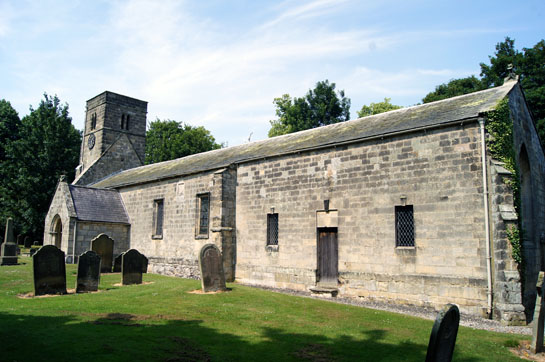|
|
||||||||||||||||||||||||||||||||||||||||||||||||||||||||||
|
Please sign my Guestbook and leave feedback |
||||||||||||||||||||||||||||||||||||||||||||||||||||||||||
|
Recent Additions |
||||||||||||||||||||||||||||||||||||||||||||||||||||||||||
|
|
||||||||||||||||||||||
|
about it. A niche on the west side of this tower has a an attractive, if unsophisticated figure of Nicholas. Within there are buttresses either side of the south door, an unusual and somewhat ugly intrusion. It is, however, the font that is the great treasure here. Along with its counterpart at Kirkburn it is of startling naivety in its execution. Its is, perhaps, this naivety that leads to some controversy over whether it is Anglo-Saxon rather than Norman and I have to confess to some sympathy with this notion. However, we have to be careful not to equate naivety with Anglo-Saxon art: both periods featured carvings of great naivety and of great sophistication, and Anglo-Saxon art forms did not die out overnight in 1066! With no evidence of an Anglo-Saxon church I think we must assume that the Norman attribution is correct until proved otherwise. Pevsner called it “A mighty and a barbaric piece. A colossal drum with wrapped more than half way round the Last Supper, the table seen half from above so as to display a variety of food”. Christ is clearly distinguishable by, amongst other things, his halo and with his hands raised in blessing. The disciples have loaves and fishes to eat and the Church Guide points out, tongue-in-cheek, that little crosses on the loaves make them look like hot cross buns! There are platters and flagons. Some hold cups or knives. The Last Supper itself is an unusual theme for a font. Besides the Last Supper we see a scene of Christ’s body being removed from the cross by Joseph of Arimathea and Nicodemus - another unusual theme.. The cross, is a “Maltese” or Amalfi cross. Why, I wonder, would this stylised form of cross be used within this very human context? Please see a discussion in my footnote below. Finally, there is a single saintly figure enclosed within a doorway, plausibly believed locally to be St Nicholas to whom the church is dedicated. |
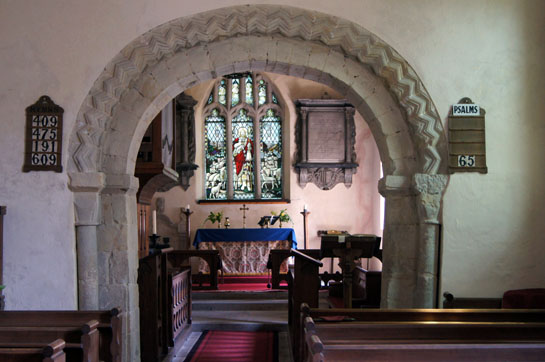 |
||||||||||||||||||||
 |
||||||||||||||||||||
|
Left: The Norman chancel arch. It has a single course of chevron moulding and plain capitals. Right: The chancel is dominated by the organ. |
||||||||||||||||||||
 |
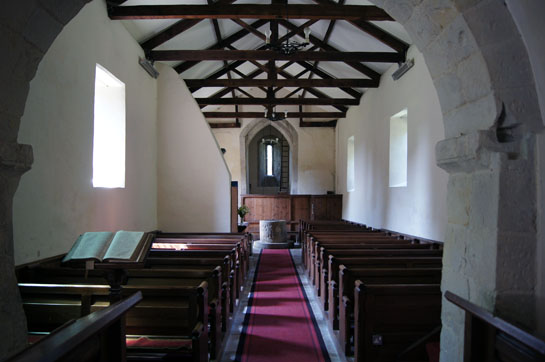 |
|||||||||||||||||||
|
Left: Looking towards the west end. The internal buttresses either side of the south door are a considerable intrusion as can be seen clearly in (right) the view to the west. |
||||||||||||||||||||
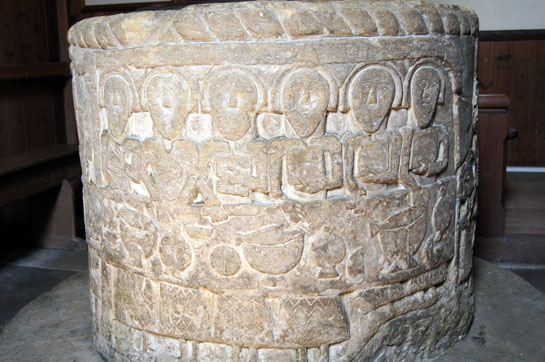 |
||||||||||||||||||||
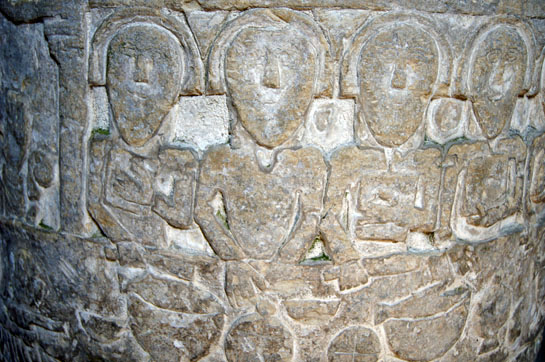 |
||||||||||||||||||||
|
Left: The Norman font showing six of the figures from the last Supper scene. There is a crude cable moulding around the lip of the font. Right: Close up of some of the apostles. Note the knives in some of the hands and the food on the table below. |
||||||||||||||||||||
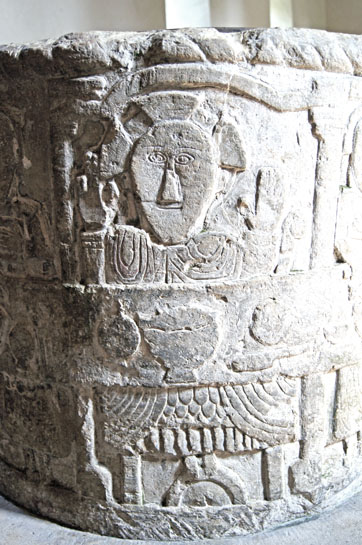 |
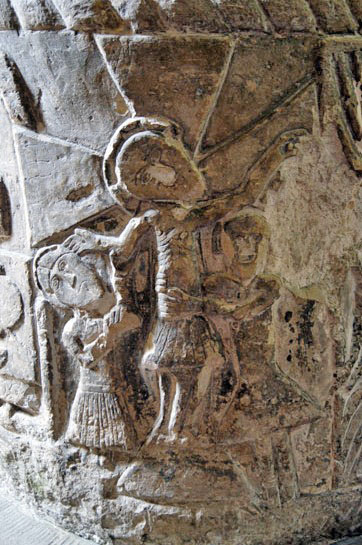 |
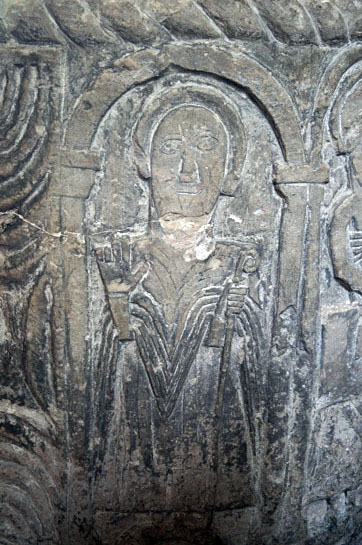 |
||||||||||||||||||
|
Left: Christ sits at the the centre of his disciples. His face is extraordinary in the child-like naivety of its execution. Both hands are raised, presumably to bless the food. He seems to be sitting on some kind of stool. Food and a knife are on the table before Him. Centre: Christ being lifted from his (maltese!) cross Joseph of Aramathia and Nicodemus. Interestingly, all three figures seem to be wearing what we would see as some kind of kilt. We can see kilted figures in a sculpture of the Magi at Kirknewton in Northumberland and I saw similarly clad figures on an Anglo-Saxon reliquary in the British Museum. But then again, these could also be cloaks. It’s odd that Christ seems also to be clothed. Right: The putative figure of St Nicholas with bishop’s mitre in his left hand and his right hand raised in blessing. He is framed by a Romanesque arch complete with capitals. |
||||||||||||||||||||
 |
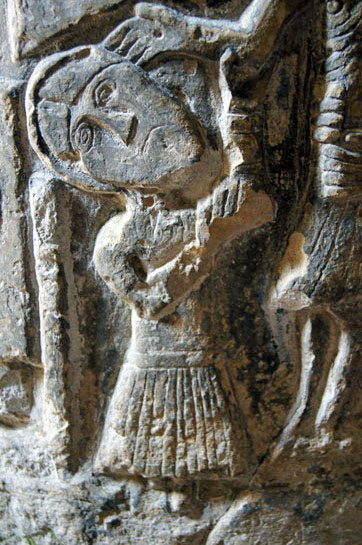 |
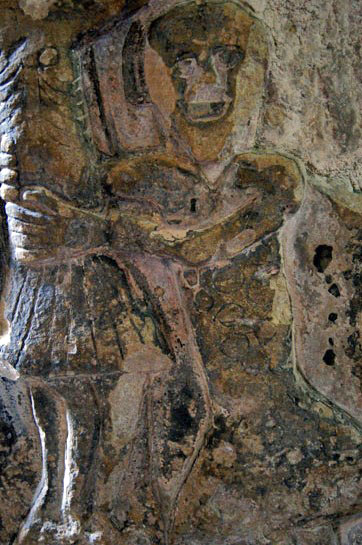 |
||||||||||||||||||
|
Left: A piece of stylised decoration between the crucufixion scene and St Nicholas. It is almost as if the sculptor ran out of ideas! However, a correspondent has suggested that it could be a “grail” which is plausible. Centre: Joseph of Arimathea. He was the legendary keeper of the Holy Grail. Right: Nicodemus who has been cursed with a rather ape-like face! |
||||||||||||||||||||
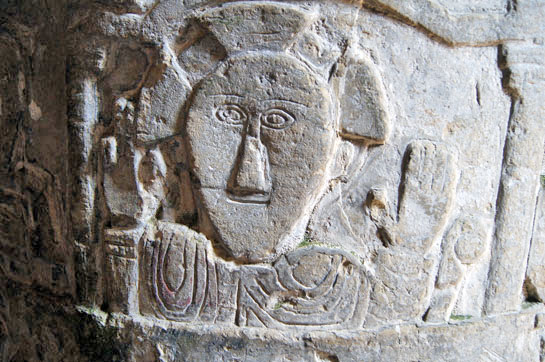 |
||||||||||||||||||||
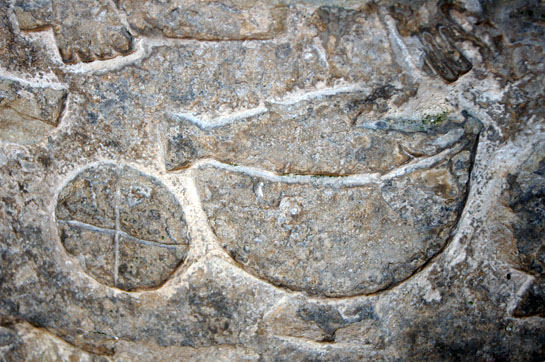 |
||||||||||||||||||||
|
Left: In front of the disciples is a bowl with a fish. Next to that is bread with a cross. Right: The face of Christ at the Last Supper. |
||||||||||||||||||||
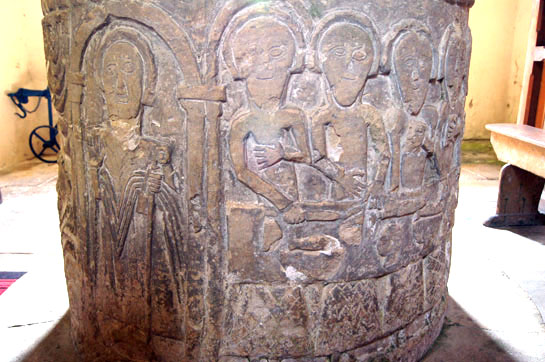 |
||||||||||||||||||||
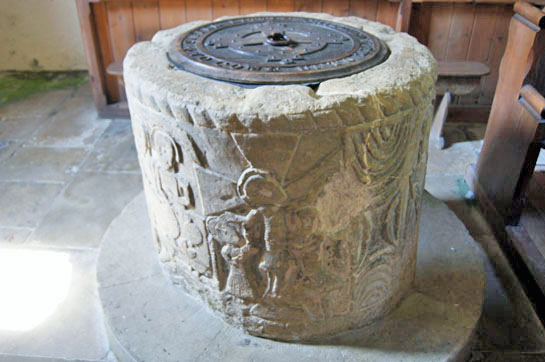 |
||||||||||||||||||||
|
Left: St Nicolas and four of the disciples. Right: The crucifixion scene with the stylised decoration to the right of it. |
||||||||||||||||||||
 |
||||||||||||||||||||
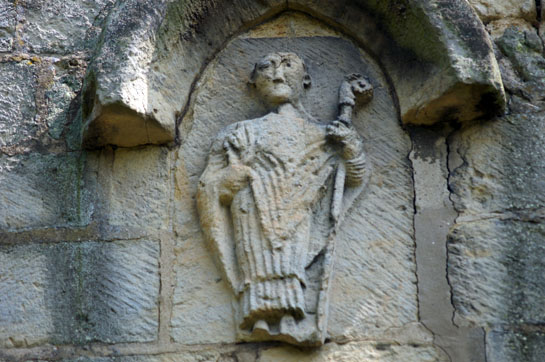 |
||||||||||||||||||||
|
Left: St Nicholas in his niche on the west side of the tower. His is a more sophisticated carving than those on the font - just look at the crozier in his hand - but perhaps not by too wide a margin! Right: The church from the norht side. Note the plain Norman north door and corbels running along the whole length of nave and chancel. |
||||||||||||||||||||
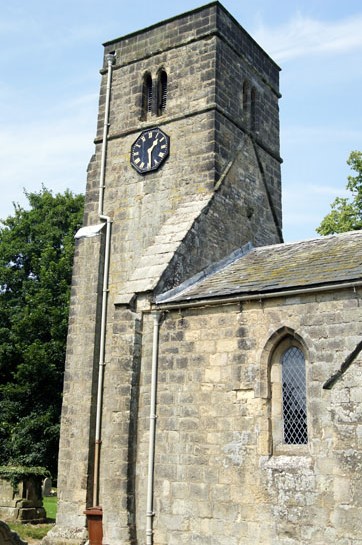 |
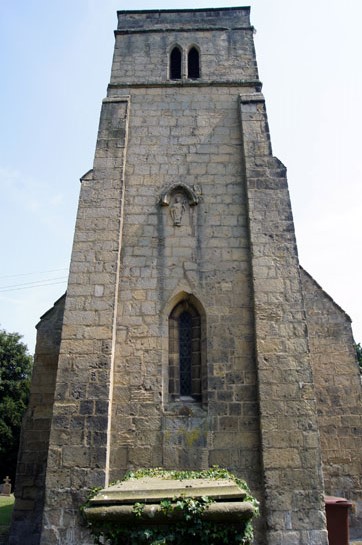 |
|||||||||||||||||||
 |
||||||||||||||||||||
|
Left: The Norman south doorway. Like the chancel arch it is lightly decorated, but not plain. Centre: The tower from the south side and the only window on this side that has escaped the attentions of “Everest Mediaeval Replacement Glazing”! Right: The tower from the west with St Nicholas in his niche over an Early English style lancet window. |
|
Footnote - the “Maltese” Cross with Musings about The Basilica of St Simeon Stylites, Syria |
||||||||||||||||||||
|
You think you can find out about just about anything on the internet but you can’t. Some things become so indelibly associated with a particular institution or group of people that no amount of googling can filter them out. If you look at stonemasons you contend with hundreds of pages of earnest discussions of Freemasonry. Kilts? Try finding something not about the Scots and/or the Irish. Maltese Cross? It’s the Knights of St John or Hospitallers and...er...Malta! Anyway, what is that Maltese Cross doing on North Grimston font? Let’s start by saying that the tendency to “fatten” the arms of the cross is an ancient one. Below I reproduce pictures I took of the basilica of St Simeon Stylites in Syria. That was completed in AD490 forsooth and we can only pray that it is not being destroyed in the current Civil War. You will see some crosses with broadened arms and some of them could appropriately be called “Maltese Crosses”. Worship there ended in AD1017 so we know, therefore, that this type of cross pre-dated the Norman Conquest and possibly by half a millennium! The Hospitallers or Knights of St John officially adopted this cross in 1126. The eight points at the extremities of the arms are held to represent the eight cardinal virtues expected of a Knight. This is firmly within the Norman period. Does it suggest then that North Grimston’s font refers to the Order? Hardly. They were barely established in this part of the country at this time. What I find unsettling about this image is that it pictorial. Christ is being lifted from a real cross and our sculptor could have been under no illusions that the instrument of death was anything other than a simple wooden cross. So why represent it in this stylised way? Was it an artistic fancy of the sculptor? Well, there is little here to suggest the work of a talented and imaginative man. It is inconceivable that our sculptor could read Latin so his knowledge of the Bible would hardly have been comprehensive. The execution here might be crude, but the subject matter is unusual and shows in-depth knowledge of scripture. We might, therefore, conclude very reasonably that this font was carved under instructions from an educated man - and educated men then meant the monks. So perhaps that maltese cross does have some symbolic meaning even within this narrative context. |
||||||||||||||||||||
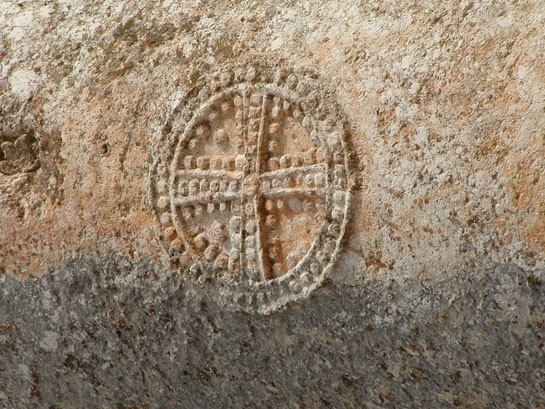 |
||||||||||||||||||||
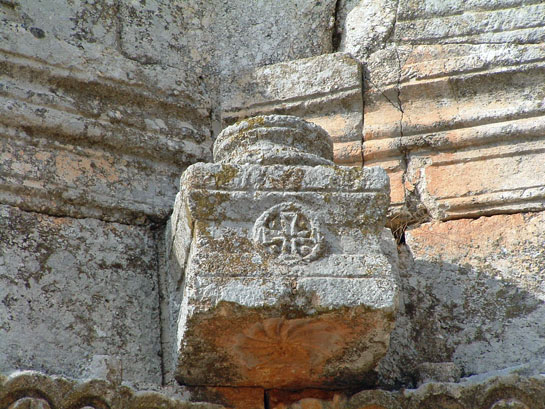 |
||||||||||||||||||||
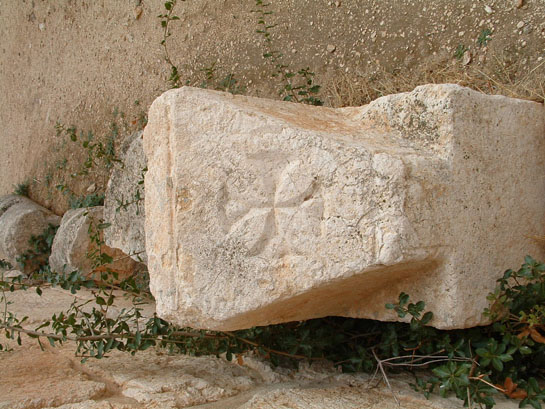 |
||||||||||||||||||||
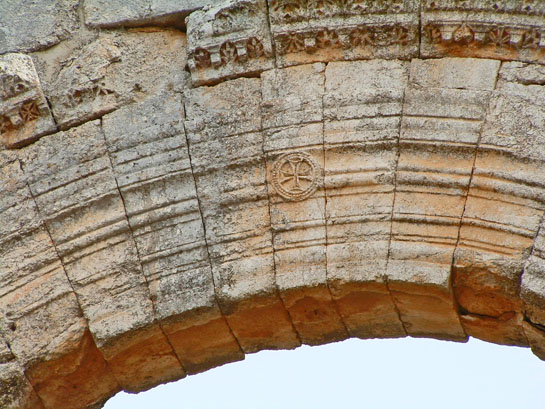 |
||||||||||||||||||||
|
Four images of crosses at the basilica of St Simeon Stylites, Syria. All show varying degrees of broadening of the arms. The one bottom left would do justice to the tailplane of a First World War German aircraft! Who was St Simeon? Well, he was the guy who decided that he had nothing better to do than sit atop a pillar for 40 years because monastic life just wasn’t sufficiently austere - he was the first “Stylite”. As his intolerance of people grew, so the pillar was raised until it reached 18 metres! You think this is tosh? Well, it is well-documented and the base of his pillar is still there. He is reckoned to be the most famous figure in c5 world and pilgrims flocked to see him. The basilica built around the remains of the pillar was, uniquely, in a cross-shaped plan. There was a hostel for pilgrims nearby that you can still see. The site is sorely in need of restoration and UNESCO did allocate funds but one presumes that all bets are off just now. Just to be self-indulgent below there are a few views of this, one of the world’s first Christian basilica. From North Grimston to Syria. What other website gives you this string of consciousness...? :-) |
||||||||||||||||||||
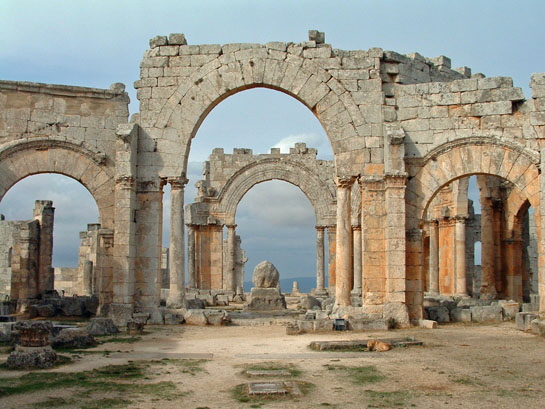 |
||||||||||||||||||||
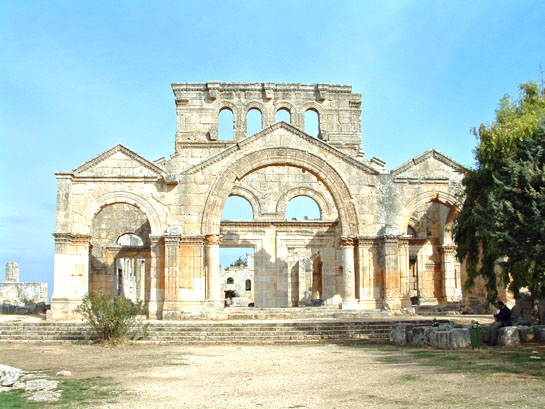 |
||||||||||||||||||||
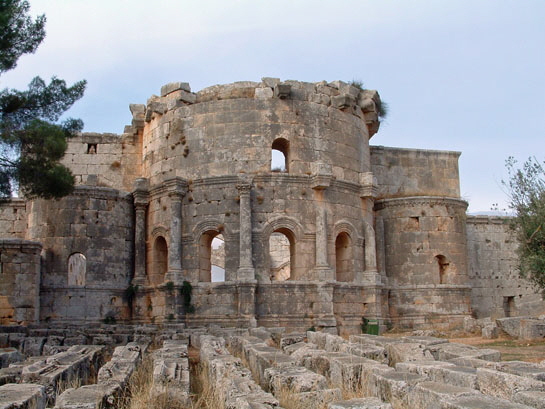 |
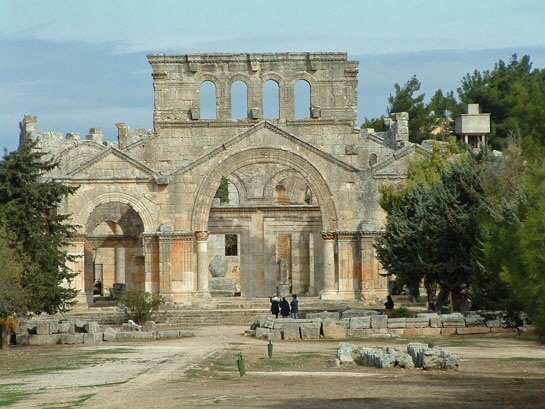 |
|||||||||||||||||||
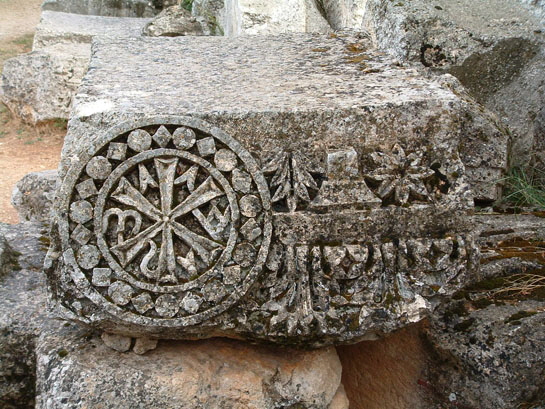 |
||||||||||||||||||||
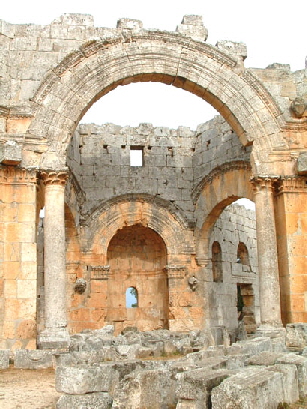 |
||||||||||||||||||||
|
I’m not going to spend ages describing all of these images. Note, however, that the basilica is very definitely “Romanesque”. Syria was an important and wealthy province of Rome that gave the state three Emperors including the famous Septimius Severus. Notice the blend of the round arches and apses so familiar in English Norman architecture with gables’ lintels and pediments from the classical world. Take particular note of the cross above left. It is a Greek chi-ro symbol still found on altars to this day with its roots in the Emperor Constantine. Within the two arms are the Greek symbols alpha and omega - “I am the beginning and the end”. You can see the image the “right” way up below. |
||||||||||||||||||||
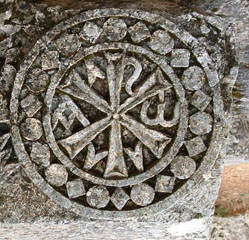 |
||||||||||||||||||||
|
|
||||||||||||||||||||
